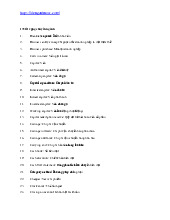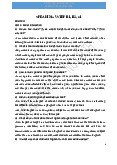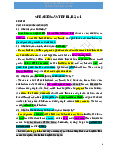

Preview text:
Finland Detects Five Mystery Underwater Explosions in Russian Waters BY ED BROWNE
ON 10/26/22 AT 9:17 AM EDT
A series of underwater explosions were detected in Russian waters by Finnish
seismologists (nhà nghiên cứu địa chấn, nhà địa chấn học /sa z ɪ m ˈ l.ə.d ɒ st/) ʒɪ
last Thursday and Friday, with the circumstances behind them still unclear.
The five explosions were detected by researchers at the Institute of Seismology at
the University of Helsinki. They determined that the blasts (sự nổ /bl st/) ɑː took
place in the Gulf of Finland near the Russian town of Vyborg, which is located
close to the border with Finland and a roughly three-hour drive east of the Finnish capital, Helsinki.
Timo Tiira, director of the institute, told Newsweek that four explosions took place
between 9:35 a.m. and 3:33 p.m. UTC on October 20, with a further explosion
occurring at 00:08 a.m. UTC on October 21.
The strength of the explosions ranged from 1.3 to 1.8, when measured in terms of
earthquake magnitude (cường độ /ˈmæɡ.n .t ɪ u ʃ d/) ː
. This is too weak to be felt by
people, but strong enough to be measured by a seismograph (máy đo địa chấn / ˈsaɪz.mə.ɡr f/)
ɑː - an instrument used to detect earthquakes.
"Signal characteristics show that these events are explosions, not earthquakes,"
Tiira said. He added that "events" had been detected in the area before, but they did not happen every year.
Tiira said the team does not know of any infrastructure (cơ sở hạ tầng / n.frə ˈɪ ˌstrʌk.t ər/) ʃ
in the area. "The Nord Stream pipe runs more northeast," he added.
The team is due to check the depth of the explosions.
Aki Heikkinen, who runs independent Twitter analysis of Russian military (quân đội / m ˈ l. ɪ .t
ɪ ər.i/) activity, tweeted on Monday that the area was apparently not
cordoned (cách ly, bao vây / k ˈ .d
ɔː ən/) off. Newsweek could not independently
verify (thẩm tra, xác minh /ˈver. .fa ɪ /) ɪ this.
The reported explosions come amid (giữa, trong bối cảnh /ə m ˈ d/) ɪ the ongoing
investigation into mysterious blasts that destroyed part of the Nord Stream 1 gas
pipeline, which runs from Russia to Germany, in late September.
Investigations revealed significant damage to the pipeline, with 50 metres (164
feet) missing from a section, according to Swedish newspaper Expressen.
Despite police investigations, it is still not known why the explosions occurred.
Russia built the pipeline with foreign partners and uses it to supply energy to other
parts of Europe. European states and the U.S. have blamed the pipeline explosions
on sabotage (sự phá hoại (vì mục đích chính trị, công nghiệp) / sæb.ə.t ˈ /) ɑːʒ ,
but it is not known who might have been behind it.
Russia has said that the U.S. and/or its allies (nước liên minh, bạn đồng minh / ˈæl.a /)
ɪ were behind the blasts. Its Foreign Ministry stated that the ruptures (sự vỡ, sự đứt /ˈr p.t ʌ
ʃər/) in the pipeline occurred in territory (lãnh thổ / ter ˈ .ɪ.tər.i/) "fully
under the control" of U.S. intelligence (cơ quan tình báo) agencies, Reuters
reported on September 29. America has denied involvement.
The explosions took place as European governments grapple (vật lộn / ræp. ˈɡ əl/)
with an ongoing energy crisis (sự khủng hoảng /ˈkra .s ɪ ɪs/) with winter
approaching, partly due to Russian gas supplies being cut off amid political
turmoil (sự rối loạn / t ˈ .m ɜː
ɔɪl/) between Russia and the West over the ongoing war in Ukraine.
Russia supplies 40 percent of the European Union's gas consumption via pipeline,
though exports have been cut by 75 percent this year.
(Nguồn: Newsweek, Finland Detects Five Mystery Underwater Explosions in Russian Water)




